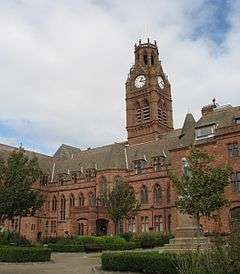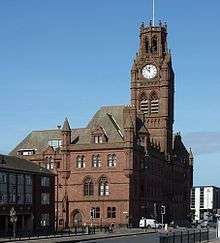Barrow-in-Furness Town Hall
Barrow-in-Furness Town Hall is a Victorian-era, neo-gothic municipal building in Barrow-in-Furness, Cumbria, England.[1] The building serves as the base of Barrow Borough Council.
| Barrow-in-Furness Town Hall | |
|---|---|
 | |

| |
| General information | |
| Type | Town hall |
| Architectural style | Victorian, Gothic Revival |
| Classification | |
Listed Building – Grade II* | |
| Designated | 6 May 1976 |
| Reference no. | 1197859 |
| Location | Barrow-in-Furness, England |
| Address | Duke Street BARROW-IN-FURNESS LA14 2LD |
| Current tenants | Barrow Borough Council |
| Construction started | 1882 |
| Completed | 1886 |
| Inaugurated | 14 July 1887 |
| Cost | £80,000 (£9.2M as of 2017) |
| Owner | Barrow Borough Council |
| Height | 50 metres (164 ft) |
| Dimensions | |
| Diameter | 72 metres (236 ft) |
| Technical details | |
| Floor count | 4 (6 in tower) |
| Design and construction | |
| Architect | William Henry Lynn |
| Architecture firm | Lanyon, Lynn and Lanyon |
| Main contractor | Short and Devlin |
The building was constructed in a four-year period almost entirely from local Hawcoat sandstone with Westmorland slate for the roof. The town hall was officially opened on 14 July 1887 by Spencer Cavendish, 8th Duke of Devonshire to coincide with Queen Victoria's Golden Jubilee.[1] At 50 metres (164 ft) tall, it amongst the tallest buildings in Barrow and lies within a Conservation Area with Grade II* listed status.[2]
History
In the mid-19th century, Barrow was little more than a small fishing village. However, after the discovery of iron ore in local mountains and the establishment of a port in the town, the local population skyrocketed to over 40,000 in the space of 20 years. In 1877 numerous architects were invited to submit proposals for a large civic building in Barrow which would represent the dramatic growth and current stature of the town.[1] Irish-born architect, William Henry Lynn had the winning design that began construction in 1882. Financial constraints alongside changes to the design were the reason that construction didn't commence immediately after selection of the design. In 1885 the building was almost complete, however cracks were found in areas of the building and the clock tower had to be completely knocked down and rebuilt. This was most likely the result of the contractors trying to cut costs by using sub-standard stone.[1] Despite these initial troubles, the town hall was finally complete in 1886 and the exterior of the building has remained more or less the same to this day. The town hall's main plaza is to the exterior of the building, which has led to many incorrectly believing that the building was built 'back to front'.[1]
Architecture
External
The English Heritage listing of Barrow Town Hall describes the external architecture as: Snecked red sandstone with ashlar dressings, graduated slate roofs. 3 storeys and attic with 6-stage tower; 1:1:5:2:4:1:1 bays in near symmetrical composition. Bays 2 & 14 have oriel bay windows corbelled over ground floor; the 2-bay section is occupied by the tower. Gothic Revival style with Geometrical tracery.[2]
Internal
The ground floor entrance hall consists of a reception and information desk alongside photos of Elizabeth II and The Duke of Edinburgh who visited the town hall in 1956. There is also a plaque commemorating the centenary of the Borough of Barrow-in-Furness which was unveiled in 1967 by The Princess Margaret, Countess of Snowdon[1] The largest room within the town hall is the Queen's Hall, which is located on the first floor and is dominated by stained glass windows which bear the images of William Cavendish, 7th Duke of Devonshire, Lord Frederick Cavendish and Lord Edward Cavendish. A number of other panels have since been added to windows in the Queen's Hall that feature certain aspects of Barrow's shipbuilding and steelworks industries.[1] Also on the first floor are the Council Chambers, the former Press and Public Galleries, the Drawing Room, the Ante Room and a large public Banquet Hall.[1]
Plazas
Two large plazas are situated either side of the town hall. They are often focal points for mass local celebrations and events, examples being Barrow A.F.C. and Barrow Raiders victories as well as the annual Christmas lights switch-on. Town Square, originally known as Cavendish Square, to the north is framed by the town hall itself and the Forum, until the turn of the 21st century vehicular traffic ran through Town Square until it was entirely pedestrianised. The rear of the town hall is landscaped and includes the statue of Lord Frederick Cavendish which was originally located in the centre of Town Square.[3]
Gallery
 The back of the town hall and tower
The back of the town hall and tower Main entrance to the town hall
Main entrance to the town hall Rear entrance to the town hall
Rear entrance to the town hall South facade seen from Schneider Square
South facade seen from Schneider Square Stained glass window bearing local coat of arms
Stained glass window bearing local coat of arms Bust of Queen Victoria inside the town hall
Bust of Queen Victoria inside the town hall Carving of a battle scene inside the town hall
Carving of a battle scene inside the town hall
References
- "The History of Barrow-in-Furness Town Hall" (PDF). Barrow Borough Council. Archived from the original (pdf) on 16 September 2012. Retrieved 4 July 2013.
- Historic England. "Town Hall, Duke Street (1197859)". National Heritage List for England. Retrieved 7 March 2015.
- Historic England. "Statue of Lord Frederick Cavendish (1292108)". National Heritage List for England. Retrieved 4 April 2020.